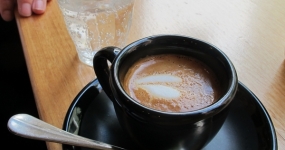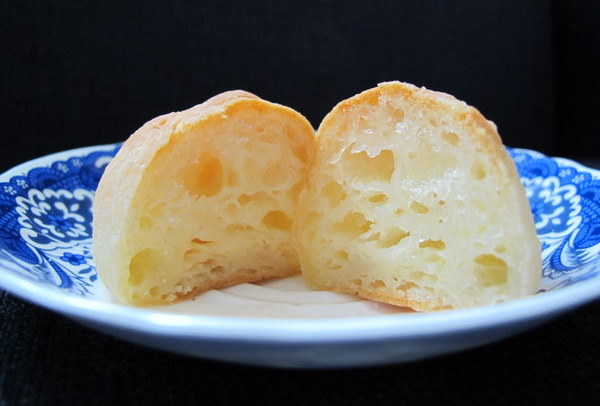Last week I talked about reliving travel through food. Taste is a powerful memory trigger and that almost explains why, about a week after my return from Argentina/Brasil I found myself showing up for drinks at a friend’s place in Newtown not with a 6-pack of beer but rather, sipping a pineapple filled with rum.
I’m not in any way implying that people in Northern Brasil show up to people’s houses with a pineapple dangling from their chops, far from it (and also, if they did, they’d use cachaça, not rum). But I couldn’t really get my head around not drinking a caipirinha and drinking it out of a pineapple, although touristy and tacky, was my favourite way to do it. This explains why Senhor R and I found ourselves hacking away at a pineapple one Sunday night to make a cup for our rum caipirinha. Sticky.
What follows is a recipe of sorts for how to turn a pineapple into a drinkable, alcoholic treat.
Caipirinha no Abacaxi
1 pineapple
3-4 dessert spoons of caster sugar
6 ice cubes
2 limes, quartered
Cachaça, or, failing that, rum
A couple of toothpicks
If the leaves of the pineapple are still attached, remove them. Chop the top off the pineapple and save it for a lid. With a long, sharp knife, cut around the inside of the pineapple almost to the bottom, leaving about a half inch border. Then cut a cross through the centre of the flesh that you hope to remove. Hack away at this with knives and spoons until you win.
In a glass or shaker, smash the hell out of the ice, sugar and limes, either with something blunt or by shaking the shaker until the sugar is dissolved. Pour into the pineapple and cover with cachaça, stir and taste. Add more sugar if needed.
Whack in a straw. Attach the lid with a couple of toothpicks. If you’re drinking your caipirinha on the beach, no worries but if you’re somewhere you don’t wanna get too sticky and your pineapple is quite ripe, you might want to put it on a plate or cling wrap it.
I don’t know about you, but travel for me is mostly about food. When I eat the thing from the place in the actual place of the thing, well, that’s not a very articulate way of putting it, but in the words of Maeve O’Meara, it’s a revelation. And there’s no better way to attempt to relive your travel than to eat the thing that you ate in the place of the thing, but this time, eat it at YOUR place.
I found myself at a bit of a loose end this week, so I decided to make Pão de Queijo (Cheese Puffs), a typical Brazilian snack/breakfast food which I don’t even particularly like, but I wish I was in Brasil right now and what better way to celebrate that than to bake. The main ingredients are manioc/tapioca starch, cheese, eggs, liquid and fat.
When baked, they look a lot like profiteroles but, although the method is similar, it is a hell of a lot more difficult as the starch makes the dough sticky and you have to knead rather than just stir it. I found this virtually impossible so I would recommend using a food processor. Pão de Queijo has a wonderfully squishy texture and these puffs are yummy straight from the oven or reheated in the microwave.
A quick tip: all the recipes I’ve read say not to let the dough sit (it doesn’t need to rise or anything); either bake it immediately or form it into balls and freeze because if you let it sit, it will magically re-liquidise!
Pão de Queijo (a combination of online recipes, this one and this one were particularly helpful)
2 cups full cream milk
½ cup melted butter
450g tapioca/manioc starch (often called tapioca flour, make sure you get one that has the texture of cornflour rather than the one with the texture of polenta),
Excess tapioca/manioc starch for shaping the dough into balls (you can also use oil or water)
3 eggs
2 cups grated cheese (traditionally queijo de minas, but I used a combination of Colby and Romano, mostly Romano)
Preheat the oven to 200°c.
In a medium pan, bring the milk and butter to the boil. Remove from the heat immediately.
Either take your chances and gradually pour the manioc flour into the pan, stirring constantly or put the manioc flour in the food processor and on a slow speed gradually pour in the hot liquid.
Allow to cool; the dough should be cool enough to knead.
Next, knead the dough or turn the food processor on to a medium speed. Add the eggs, one at a time, incorporating each egg completely before the next egg is added. The dough should be smooth and elastic but still very soft and sticky. Add the cheese and knead well until completely incorporated.
You now have 3 choices – flour your hands with tapioca flour, oil them or dampen them. Then roll the dough into even, 2-3cm balls and place on a baking tray lined with baking paper or a silicone mat.
Bake for about 20 minutes, checking after ten minutes to make sure they are not over browning. They are done when they sound hollow when tapped, as they cool they will soften. Freeze or store in an airtight container, best served warm or reheated for 10 seconds in the microwave.
Makes about 30.
What foods from your travels do you love to cook?
About me
 Sharing easy recipes, hunting down the best coffee. Honest accounts, nothing too serious. Read more...
Sharing easy recipes, hunting down the best coffee. Honest accounts, nothing too serious. Read more...Recent Posts
- Aerpress means no more shit #travelcoffee and #workcoffee
- Why I write and four ace bloggers who do it better
- The five best things I ate in London
- Shoreditch is awesome, airports are not
- I quit sugar? Do I bollocks.
- Cubao Street Food, Alexandria
- The Reformatory Caffeine Lab, Surry Hills
- Brewtown Newtown
- Stay caffeinated over Christmas
- Gumption by Coffee Alchemy, Sydney CBD
Popular posts this month…
 Sparkling Long Black posted on May 10, 2011
Sparkling Long Black posted on May 10, 2011  Review – Philips Saeco Intelia posted on January 10, 2012
Review – Philips Saeco Intelia posted on January 10, 2012  Kosher Whole Orange Cake posted on July 5, 2011
Kosher Whole Orange Cake posted on July 5, 2011  The quest for Mex part 2 – Feisty Chicken Burritos posted on December 21, 2010
The quest for Mex part 2 – Feisty Chicken Burritos posted on December 21, 2010  Cheat’s Dulce de Leche posted on January 7, 2011
Cheat’s Dulce de Leche posted on January 7, 2011  The Grounds of Alexandria posted on April 4, 2012
The Grounds of Alexandria posted on April 4, 2012  Naked Espresso, Melbourne CBD posted on February 22, 2013
Naked Espresso, Melbourne CBD posted on February 22, 2013  Coffee in Buenos Aires – Srsly, WTF?? posted on July 30, 2011
Coffee in Buenos Aires – Srsly, WTF?? posted on July 30, 2011
Disclaimer:
All opinions in this blog are mine, an everyday, real-life person. I do not accept payment for reviews and nor do I write sponsored posts. I do not endorse the content of the comments herein.










